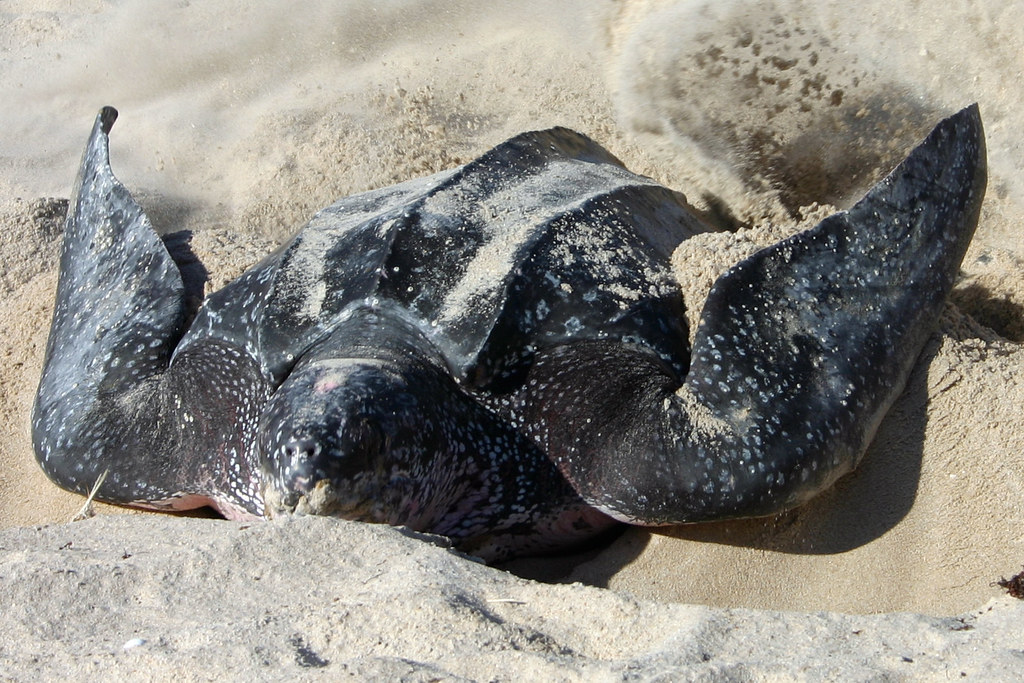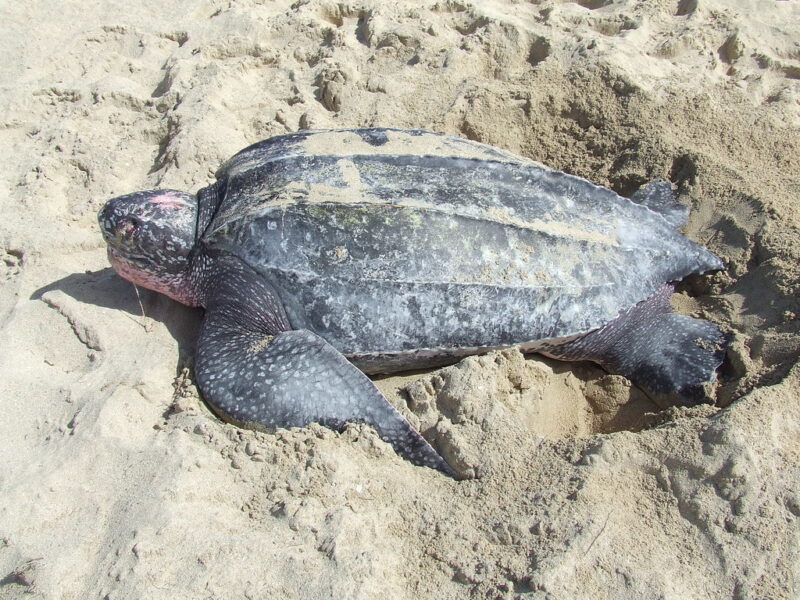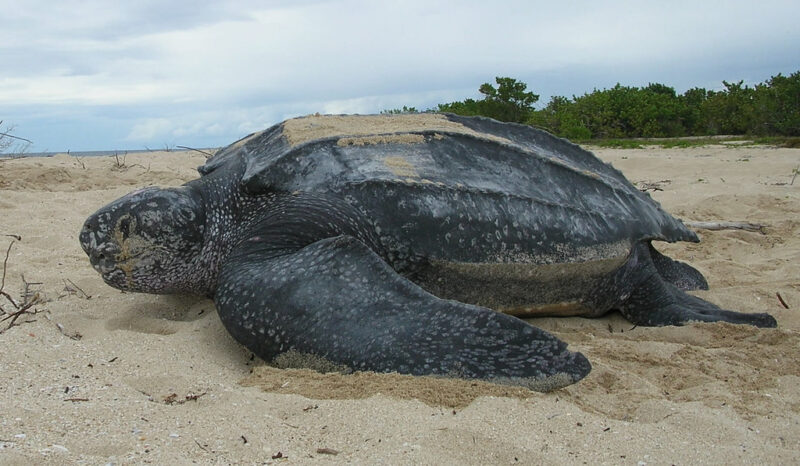Some cool facts about the Leatherback Sea Turtle.
Highlights
Scientific Name: Dermochelys coriacea
Status in the Wild: Endangered
Habitat: Oceans
Diet: Carnivore

The leatherback sea turtle is the largest of the turtle species. It is the only surviving member of a family of sea turtles that evolved around the time of the dinosaurs (Dermochelyidea). All other living sea turtles are more recent and belong to the family Cheloniidae. In spite of their ancient history, these deep-diving, cold-water turtles have undergone fascinating adaptations similar to those of arctic marine mammals.
Leatherbacks regularly grow more than 5 feet long and can weigh more than 1,000 pounds. In 1988, one of the largest male leatherbacks was found in a fishing net off the coast of Wales. It weighed 2,015 pounds and had an 8-foot flipper span. However, the turtles found off the Pacific coast of Costa Rica are smaller than those from other areas; their shells measure 4.5 to 5.5 feet long. The reason leatherbacks are so large, in general, is that their great size enables them to retain heat in cold waters.
Almost all turtles have flattened, widened ribs that fuse together and form a shell of bone called a carapace. This carapace covers a thin sheet of corneas tissue that is almost identical to human fingernails. However, leatherback ribs are not united, and between them are flat pieces of bone, about three-quarters of an inch wide. These bones embed in the turtle’s skin and make the “shell,” which is oily and leathery—hence the turtle’s name.
The leatherback’s body proportions and streamlined shape enable it to swim the same distances as other sea turtles while using less energy. The shape of the shell maximizes hydrodynamic efficiency. Like keels on a boat, the seven longitudinal ridges on the shell facilitate travel through the water. The turtles are equipped with unusually long, strong flippers that measure more than half their body length. Their power comes from massive pectoral muscles.

Leatherbacks prefer to nest on beaches that have a deep-water approach, strong wave action and a steep slope to the dunes. On this type of beach, they can reach the dunes without hauling their massive bodies over long distances. Nesting occurs in the dark—most of it in the middle of the night—and only during high tide. Most nesters prefer not to crawl longer distances to the dunes when the tides are low.
After the female reaches the high tide line, she makes a depression in the sand with her flippers. Resting in this body pit, she uses her hind flippers to dig a hole in which to lay her eggs. Leatherbacks lay fewer eggs than other marine turtles, averaging less than 85; however, the cue ball–sized eggs are the largest of all sea turtles. These eggs do not break when they fall into the 40-inch deep hole because their shells are leathery and pliant. The last eggs the female deposits are smaller, nonsymmetrical and yolkless. The purpose of these eggs is unknown; however, one theory is that because the leatherback’s eggs are so large, in general, it would be very easy for sand to fall between them and fill up the air spaces that provide oxygen for incubation. These smaller eggs on top of the clutch may “cap” the eggs and keep the sand out.
After filling in her nest, the female piles up sand on each side of her body by sweeping her front flippers. In doing so, she hides the nest and increases its depth. To conceal it even more, she crawls a few yards away and scoops out several more false body pits. She then returns to the sea, often making tight circular loops on the way to the water. She probably does this to orient herself toward the lightest part of the horizon, which is, under natural conditions, the ocean.
Ten days after she has laid her first nest, the female returns to the beach to lay another clutch of eggs. She will repeat the cycle nine times in a single nesting season. On the Pacific coast they nest during the months of September to March, especially on Naranjo beaches, within the Santa Rosa National Park, as well as Grande beach in Guanacaste and Playa Langosta, as well as Ventanas Beach. On the Caribbean coast, the season is from February to August, being best March to July.
After laying her final clutch, the female will not return to lay eggs at her nesting beach for two or three years. The eggs, which are located deep under the sand, take up to 70 days to hatch. This incubation period is longer than that of any other sea turtle because other turtles dig shallower nests in which the increased temperature quickens development.

Threats.
Unfortunately, sea turtles are a delicious meal for many animals, and they are covered with beautiful tortoiseshell—characteristics that have driven six of the seven species to the brink of extinction. Turtle meat was an appealing change to the salt pork and hardtack crackers that comprised the diet of sailors of old. Some maritime people still enjoy sea turtle meat, and the sale of sea turtle eggs is prolific as they are served illegally in restaurants from Sri Lanka to Nicaragua. The egg sacs are sucked from the shell, and there remains a belief that the eggs act as an aphrodisiac. Carved and polished trinkets made from tortoiseshell fetch a high price, and the mottled combs and jewelry are still sold in markets despite CITES ban of the tortoiseshell trade worldwide in 1973. Beauty products contained sea turtle oil and were produced until the 1970s, with the thought that the long-lived turtles had oil in their bodies that produced skin-rejuvenating effects. Additionally, turtle skin is sometimes poached and used as a replacement for alligator skin to craft leather goods such as purses and shoes.
The conservation organizations are working to manage and protect the beaches that are crucial sea turtle nesting sites, crack down on their illegal trade, and reduce sea turtle bycatch by supporting sustainable fishing practices. Another hope for the sea turtles’ survival is sustainable ecotourism, the notion that people will travel great distances to admire, learn about, and be inspired to conserve this magnificent species
